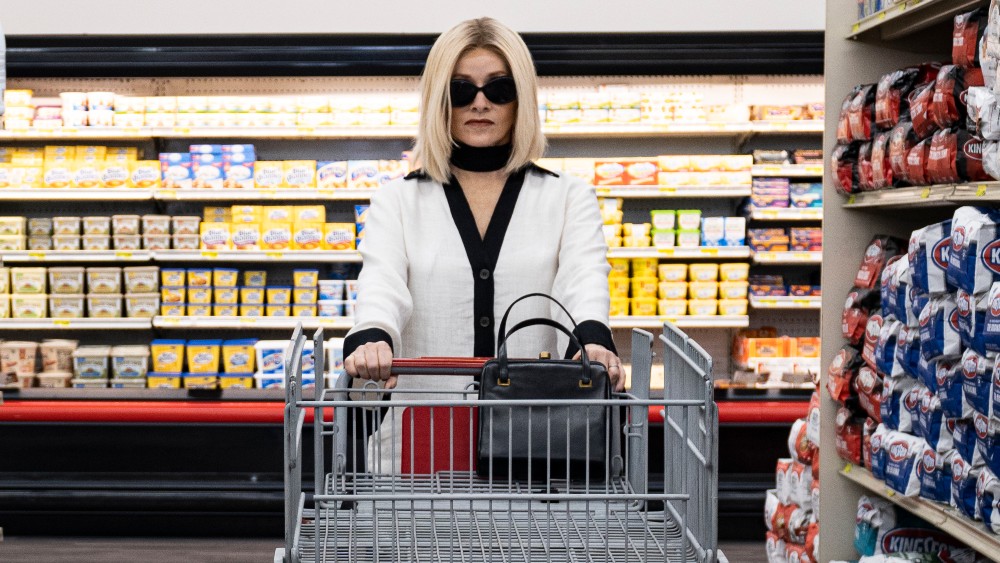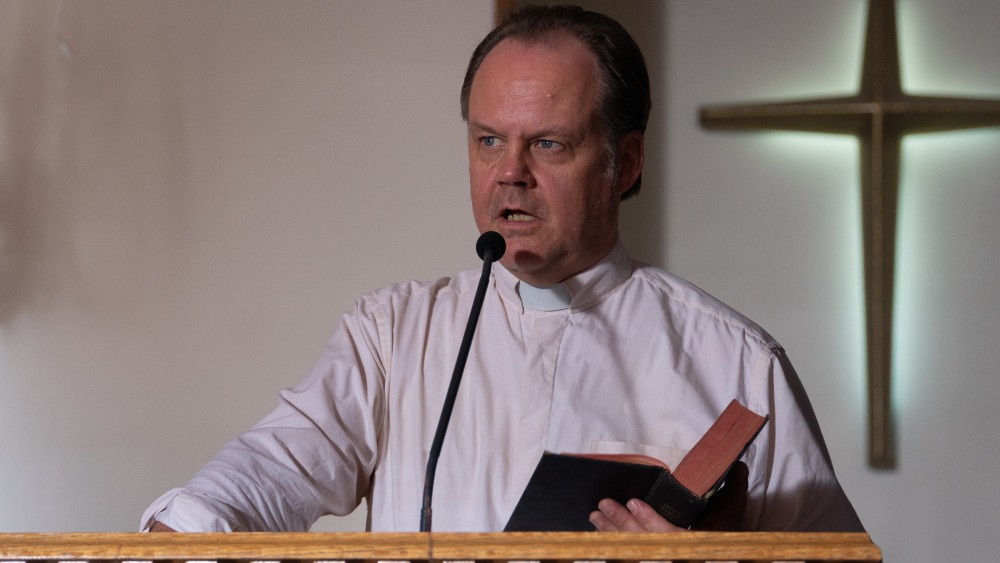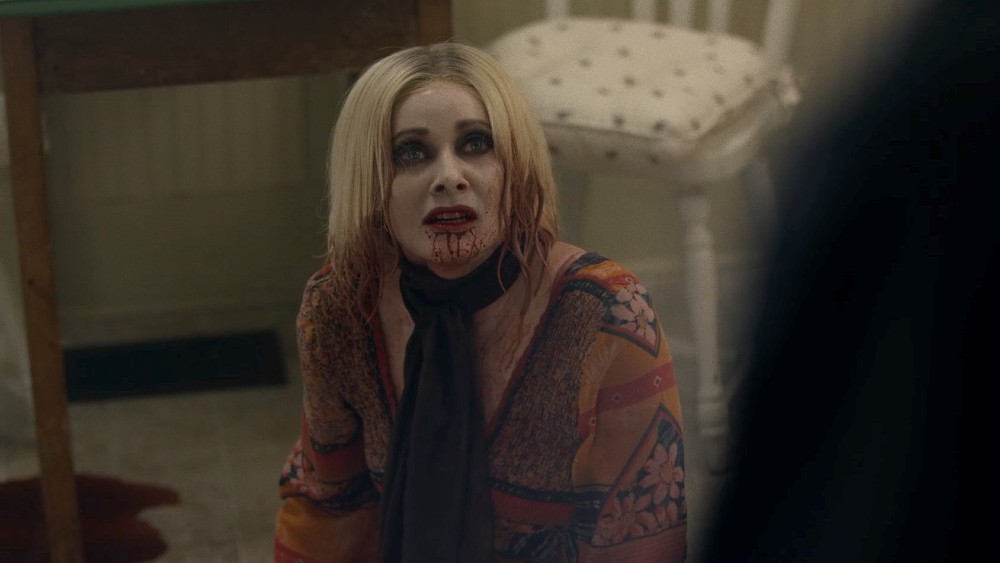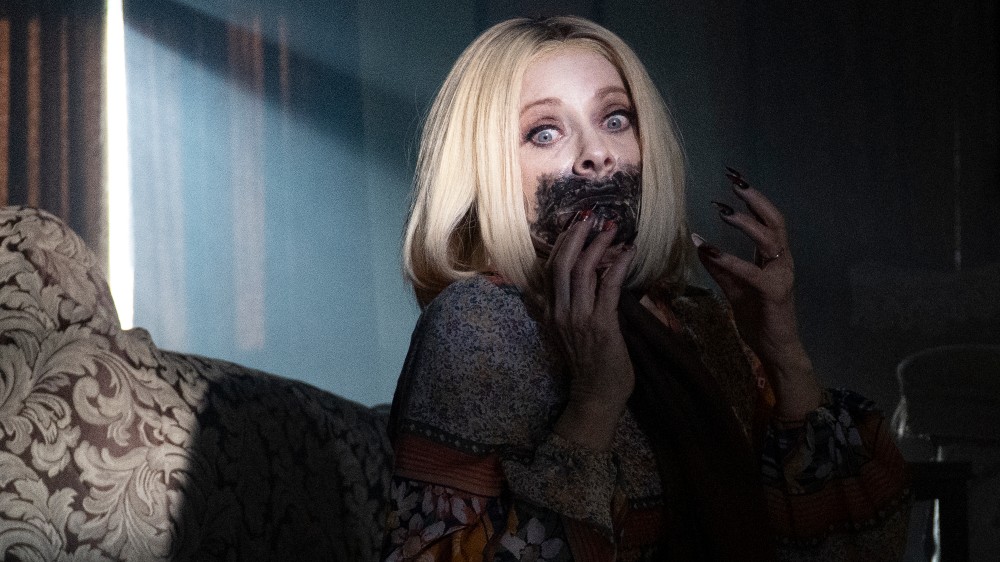
If you’re any sort of horror enthusiast, especially of the horror flicks of the ’80s, you likely will know the names and work of Barbara Crampton and Larry Fessenden.
Although Crampton hates the term “scream queen,” she is still quite beloved for her work in movies like Re-Animator and Chopping Mall. In recent years, she’s become a bit of a “Grand Dame” of horror as fans of her ’80s work have become filmmakers themselves and discovered her to still be one of the finest actors of the genre. Similarly, Fessenden continues to be one of New York City’s top indie horror mavens, continuing to make lower budget films in the genre but also shepherding newer filmmakers like Ti West, Kelly Reichardt and Jenn Wexler, as a producer. He’s also a fine and quite underrated actor himself.
The duo offers an impressive pedigree as the two leads of Jakob’s Wife, the second film from Travis Stevens as a director after producing a number of great indie horror films himself. The movie puts Fessenden and Crampton in the roles of dysfunctional husband and wife, Pastor Jakob Feder and his wife Anne, who has spent the last thirty years as the “loving housewife” but deeply unhappy with unable to live her fullest life. An encounter with a mysterious being changes things for her but also introduces all sorts of mayhem into their lives and those around them.
Below the Line got on the phone with Stevens last week to talk about the movie and how it all came together… in Mississippi, of all places.
Below the Line: When I heard about this movie and saw your name on it, I vaguely remembered the name before realizing that you produced Ted Geoghegan’s two movies. Then, I saw that your movie starred Barbara Crampton and Larry Fassenden, who were both so great in Ted’s movie We Are Still Here, so I was sold.
Travis Stevens: I appreciate it. I think all of us are indebted to Ted for bringing us into each other’s orbit. We love Ted.

BTL: Did you already have this movie in mind when you produced that movie?
Stevens: No, no, this movie came to me through Barbara. She had found the original script and had been working on getting it made for some time and brought it to me. Then when I read it, I immediately saw a great role for Larry to play as her husband, and she had the same thought and had reached out to Larry as well. So we all were on the same page or it just happened to be obvious.
BTL: It’s an amazing vehicle for Barbara, so I’m glad she got it made, and Larry as a preacher is also genius casting. I would watch a hundred movies with the two of them together, so keep making them.
Stevens: It would be a pleasure, because they’re both really experienced and really, really talented, but they’re also both really, really nice. It’s so enjoyable to go to work with really nice, kind, supportive people. I would love to continue making movies with them for years, because they just bring so much to the table.
BTL: They could be the Tracy and Hepburn of horror. You can quote me on that.
Stevens: Very nice. I will.
BTL: Did you shoot this entire movie down in Mississippi or just parts of it?
Stevens: Yep. The whole thing down in Canton, Mississippi,
BTL: How did you end up down there?
Stevens: In the time of year we were shooting, we were looking at different places. In New England, we’d done a few movies up there, Louisiana. We were looking at Canada for a minute. And Mississippi, just the timing and there’s a little film community on the ground there. We’ve had some friends that have made movies there in the past — Patrick Reynolds and Mike Mendez. So we basically had some introductions to people who had made horror films, and it made it a lot easier to go into a new place that we hadn’t shot before. There’s a company down there, Eyevox Entertainment — Rick Moore runs that — And then the DP David Matthews is down there, and there were many, many locals who welcomed us with open arms and helped us make this movie.
BTL: I’ve actually spent a lot of time in Mississippi — I was actually there last weekend for the Oxford Film Festival, so I’m glad to see people are discovering Mississippi and all the good and talented people working there.
Stevens: Paul Schrader‘s movie was shooting down there when we were shooting, so there’s an appetite for making movies down there, and there’s a really talented crew base. So I hope people continue to sort of work down there, and it grows and grows and grows.

BTL: I was really amazed by the group you put together, because not a lot of them have done many things, or at least not stuff that I had heard of. However, you found them and put this group together, the movie turned out great.
Stevens: With any job interview, you’re in a very short window of time. You’re trying to determine someone’s taste level, their cinematic references and background. Are we going to be able to talk movies in the same way and have the same reference point and their potential if maybe they’re at the beginning of their careers, and their temperament? One thing that’s always nice about making movies in the South is everybody is incredibly easy to get along with, incredibly warm, and it makes it nice.
But I’m really happy with the team we put together. I think another aspect that was really important for this movie in particular, but movies in general, is really bringing on a lot of smart and talented women to be department heads. So, Yvonne Reddy, who did the costuming and Mary Czech, who did the beauty, hair and makeup, Tara Busch, the composer, Lilly Bolles and Danica Vallone, who were production designers. Kim Barnard, who’s the First AD. All of them had to deal with circumstances on this movie that would have challenged a much more experienced person, and they navigated it with just such finesse, and the movie probably would not have turned out as good if they couldn’t problem solve the way they did. So I feel super blessed.
BTL: How do you test someone’s temperament when you’re talking to people for a job interview?
Stevens: Yeah, it’s hard. You can certainly get references, you certainly look at the other work they’ve done. Like anything — I mean, it’s gonna sound lame — but you try to look through social media and just sort of get a sense of who this person is outside of the job interview, and that can go a long way. These shows can be so challenging. It only makes it worse, if somebody doesn’t want to be there, or there’s an aspect that you hadn’t sort of known about before starting work. So anything you can do to hire the right people for the right role on that particular movie is only going to result in a better experience and a better movie for everyone.
BTL: Did you find that you’re looking at things differently as a director yourself vs. when you’re producing something and helping a director make his or her choices? Did your experience as a producer inform you as a director when making those choices?
Stevens: For sure. I think starting, particularly after this one, I’d been primarily thinking in terms of as a producer: how do you get it done for the resources you have in the window you have with the talent you have and all of that? I think that’s a sort of mindset that takes some time to grow out of. So I’m trying to think more in terms of a director and trying to think more in terms of, “Oh, actually, I need to say ‘no’ here,” or we need another solution here. Obviously, everybody has the same goals in mind, and everybody wants the movie to be successful. So there’s not animosity driving this, but I do recognize that as a producer, you always think, “Well, we can make something good with this.” And as a director, you realize, “Hmm.. it can only be so good with this.”
BTL: I loved some of Dave Matthews’ decisions while shooting this, as there’s lots of close-ups of Larry and Barbara’s mouths.
Stevens: That was something that was important to… I mean, it’s a vampire movie, so I really wanted to… there’s even stuff that’s not in the movie, but I basically wanted to accentuate the mouths. There’s subtle little jokes like the little kid they encounter at the end, she’s losing teeth as a kid, just stuff like that. It’s a fun little layer to add to a vampire movie.
BTL: It takes some time before you even realize you’re watching a vampire movie, because it avoids so many tropes early on, and you’re not really sure where it’s going. Can you talk about creating that pacing and allowing the horror elements to sort of creep in and then explode as it goes on?
Stevens: The idea was to start the movie much like the main couple’s lives, which is kind of a bit drab and a bit small and have their lives and the movie transform in wild and vibrant ways once she gets bit, so the movie actually changes along with its main character as it goes along.
BTL: I’m not sure if you mentioned the person who did the special makeup effects for the movie, but obviously, in a movie like this where you have an amazing amount of gore, which I loved, but also the vampire, I guess The Master, her movie was pretty amazing, also. Who did that work?
Stevens: Oddtopsy Effects, which is Marcus Koch and his partner Jessie Seitz. We had first worked together on We Are Still Here, we did Mohawk with them as well, and another film together. Yeah, they’re great, and I just lived in an Air B&B with them. So we would shoot all day, and then at night, go back to the house and work on the stuff that was gonna end up on screen the next day. They’re really, really fun film nerd, special effects artists, and I just really loved being around them, because they had such an appetite.
BTL: I definitely saw some of the Cronenberg influences in some scenes and giallo stuff, but I love how the blood would just slowly drip and then exploded like water everywhere. I think We Are Still Here had similar scenes where the blood would behave that way.
Stevens: I think in general, there’s a lot of more subtle horror being made right now, and it seems kind of fun to occasionally go back to something a bit bigger and bolder, especially in this case when it’s Barbara Crampton. What are the movies that put Barbara Crampton on the map back in the ’80s? We kind of wanted to honor those, as well.
With Marcus, that’s the funny part of the process is I’ll say, “Okay, I’m thinking a lot of blood here.” And he’ll be like, “Okay, how about this?” I’m like, “No, no, no, more, a lot of blood.” And so we keep scaling up the gags, and he has to keep inventing new ways to project that amount of blood into whatever work we need at that moment. And he’s always game. He basically took a pump and reversed the motor on it, so it could blast out blood and we just reversed it.
BTL: That was pretty amazing, and I haven’t seen a good rat movie in a long time, so where did you find a rat wrangler down there?
Stevens: Well, it’s a small show, so I did the cursory reach-out to animal trainers in Hollywood, and found out that that was well out of our price range. But we were able to connect with a local woman, Lexi Payne, down in Mississippi, who raises rats for pet stores. When I talked to her about what our needs were, she said, “Yeah, I think I can get you 40 rats by that date.” So that’s what we did. Untrained, just good, polite, Southern rats.
BTL: Did you say 40 rats? Living in New York City, I could see that many rats on a summer night out, but they’re not at all well-behaved. I think the headline for this story might be “How to Find a Local Rat Wrangler on a Budget.”
Stevens: Yeah, it’s a very specialized field. I think just the producing mindset as I was writing, I was like, “Well, I know this is probably out of our budget range, but how do I solve this problem?” I had seen a movie a few years ago called Rat Scratch Fever that was made by a guy, I think Jeff Leroy was his name, and it was basically giant rats terrorizing the city. I was like, “Well, that movie was very modestly budgeted. How did he do it?”
So I reached out to him on social media, and he came back to me and he said, “Oh, I just bought some rats from the pet store, and I just shot him in the cage with my miniature sets.” And I was like, “Okay, well, he got some pretty good performances out of those rats, so maybe that’s an approach we can take.” I was glad it worked out.
BTL: You mentioned your composer Tara Busch, who has done a few things on other movies, but this was the first feature she scored, and it turned out great. How did you find and connect with her? What kind of direction did you give her or what movies did you talk about?
Stevens: Thank you. Yeah, she had done an opening set at the Beyond Fest screening of Starry Eyes, another movie I produced, and she’d just been on my radar. On this movie, because I wanted us to get the feminine voice in this film as strong as possible, because the movie is about Ann and what’s going on in her head. So during the writing stage, I reached out to her and said, “Hey, we’re doing this smaller movie, and I’d really like a female composer, and especially somebody who has vocals as an element of their work, because I think that would give us an opportunity to basically vocalize Ann’s interior monologue.”
And Tara had said, “Yes, this is something I’ve wanted to do for a long time and haven’t had the opportunity to.” So she was gung-ho, I was gung-ho, and she started sending little pieces of music during pre-production, while we were in production. This was the longest period of time that I had to work with a composer on the score, which was really beneficial, because we were able to really dial-in the score in a way outside of the usual constraints of schedule.
The movies we talked about on this one… because the movie was going to be in this style of ’80s horror films, it was really important for the score to have the pulse of those films. I think a lot of contemporary horror scores, especially temp scores, are sort of drony and repetitive-based. On this, we wanted the silence and the sorts of peaks and valleys of what’s happening in the scores to be much more specific and tied to what was happening on screen. We had a long process of really trying to dial in these… as the edit was changing, she would redo the scored to fit the new timing. It was really great, she’s an incredible composer, and I can’t wait for other people to hire her. So I get to listen to her work in other films as well.
BTL: I want to ask about working with Barbara as a co-producer. I feel like actors, in general, should be more involved with the writing and production of their movies, since it’s important to be passionate about what you’re acting in. How involved was she in picking some of these people we’ve discussed?
Stevens: She was an active producer. She found the material, nurtured the material, got the material set-up at a production company, and was there every step of the way through post-production. And her voice is in this movie, and there was a nice parallel between what she was doing as an individual and what her character does in the movie itself. She has so many relationships in the business, whether it was sound designers or VFX people or editors and whoever we were looking at hiring, she would put names in the mix. That’s just a testament to how active in the horror community she is. She is an amazing producer.
Jakob’s Wife will be available to watch in theaters, on-demand and digitally Friday, April 16.
All photos courtesy RLJEfilms and Shudder.







